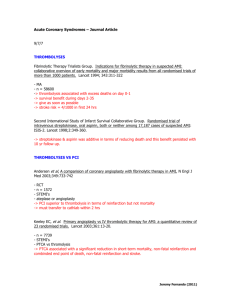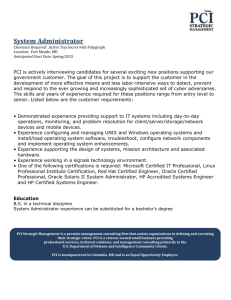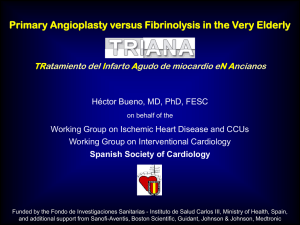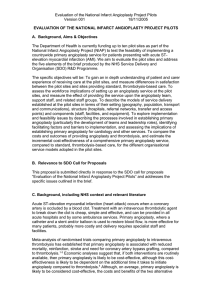Caulfield - OAT Trial
advertisement
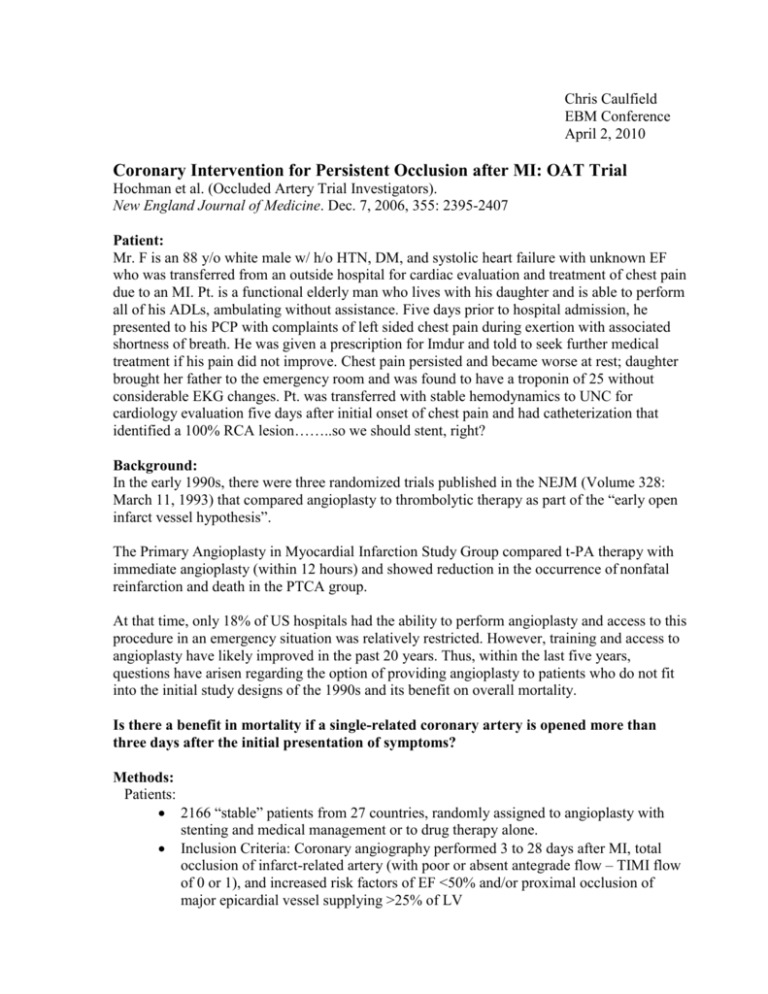
Chris Caulfield EBM Conference April 2, 2010 Coronary Intervention for Persistent Occlusion after MI: OAT Trial Hochman et al. (Occluded Artery Trial Investigators). New England Journal of Medicine. Dec. 7, 2006, 355: 2395-2407 Patient: Mr. F is an 88 y/o white male w/ h/o HTN, DM, and systolic heart failure with unknown EF who was transferred from an outside hospital for cardiac evaluation and treatment of chest pain due to an MI. Pt. is a functional elderly man who lives with his daughter and is able to perform all of his ADLs, ambulating without assistance. Five days prior to hospital admission, he presented to his PCP with complaints of left sided chest pain during exertion with associated shortness of breath. He was given a prescription for Imdur and told to seek further medical treatment if his pain did not improve. Chest pain persisted and became worse at rest; daughter brought her father to the emergency room and was found to have a troponin of 25 without considerable EKG changes. Pt. was transferred with stable hemodynamics to UNC for cardiology evaluation five days after initial onset of chest pain and had catheterization that identified a 100% RCA lesion……..so we should stent, right? Background: In the early 1990s, there were three randomized trials published in the NEJM (Volume 328: March 11, 1993) that compared angioplasty to thrombolytic therapy as part of the “early open infarct vessel hypothesis”. The Primary Angioplasty in Myocardial Infarction Study Group compared t-PA therapy with immediate angioplasty (within 12 hours) and showed reduction in the occurrence of nonfatal reinfarction and death in the PTCA group. At that time, only 18% of US hospitals had the ability to perform angioplasty and access to this procedure in an emergency situation was relatively restricted. However, training and access to angioplasty have likely improved in the past 20 years. Thus, within the last five years, questions have arisen regarding the option of providing angioplasty to patients who do not fit into the initial study designs of the 1990s and its benefit on overall mortality. Is there a benefit in mortality if a single-related coronary artery is opened more than three days after the initial presentation of symptoms? Methods: Patients: 2166 “stable” patients from 27 countries, randomly assigned to angioplasty with stenting and medical management or to drug therapy alone. Inclusion Criteria: Coronary angiography performed 3 to 28 days after MI, total occlusion of infarct-related artery (with poor or absent antegrade flow – TIMI flow of 0 or 1), and increased risk factors of EF <50% and/or proximal occlusion of major epicardial vessel supplying >25% of LV Exclusion Criteria: Left main or triple vessel disease, hemodynamic instability/shock, serum Cr >2.5, angina at rest, severe ischemia on stress testing, and NYHA class III or IV heart failure. Protocol: Randomization was performed via a permuted-block design within each study site. All received ASA, ACE-I, BB, lipid lowering therapy, and anticoagulation if indicated; Thienopyridine (i.e. Plavix) was initiated before and after in PCI group. Those in PCI group underwent procedure within 24 hours after randomization, and stenting was recommended (8% received DES) with a success noted as stenosis <50% with TIMI flow of 2 or 3. End Points: Primary: Composite outcomes from death of any cause, nonfatal reinfarction, or NYHA class IV heart failure at 4 years. Secondary: Individual primary outcomes as well as clinical symptoms, economic problems, and overall quality of life. Validity: * Were patients randomized to treatment groups? Yes, overall acceptable study with appropriate randomization, study length of 5 years, power of 94%, and no subgroup variability. * Were all patients analyzed in the groups to which they were randomized? Yes and no, there was cross over of patients from medical to PCI group with an as-treated analysis, but did not affect overall outcomes and statistical significance. * Was centering effect taken into account due to multiple facilities? Unsure and evaluation of heterogeneity vs. homogeneity was not discussed in article. Results - Primary end points were reached in 161 patients in PCI group vs. 140 in medical therapy. - Estimated 4-year cumulative event rate was 17.2% PCI group vs. 15.6% medical therapy, which showed no statistical significance (hazard ratio of 1.16; 95% CI, 0.92 to 1.45) ** Of statistical significance, there was a greater occurrence of site-determined nonfatal reinfarction in the PCI group (9.4%) vs. medical therapy group (7.2%); hazard ratio 1.43; 95% CI, 1.02 to 2.00 -> international diagnosis of MI was redefined; relies primarily on cardiac markers. 1) Small vessels/collaterals that formed as a result of occlusion, now have reduced flow so if re-stenosis/re-occlusion occurs, collaterals may no longer be present. 2) Dislodging of clot/plaque at time of procedure could cause myocardial damage. - No statistical significant differences (CI included 1) between groups of other primary and secondary end points. - Less angina in PCI group at 4 months and 1 year, but by three years, there was no difference. Conclusions ** There is no clinical benefit in terms of reduction of death, re-infarction, or heart failure during a mean follow-up of 3 years in patients who received PCI 3 to 28 days after initial onset of symptoms of an MI. *** So what happened with our patient? Does this study apply to our patient’s presentation?






